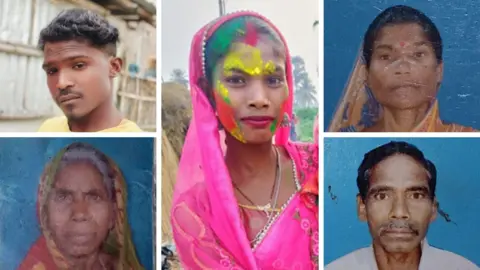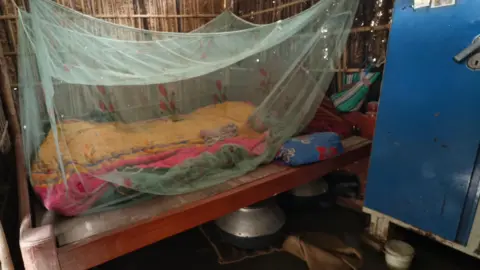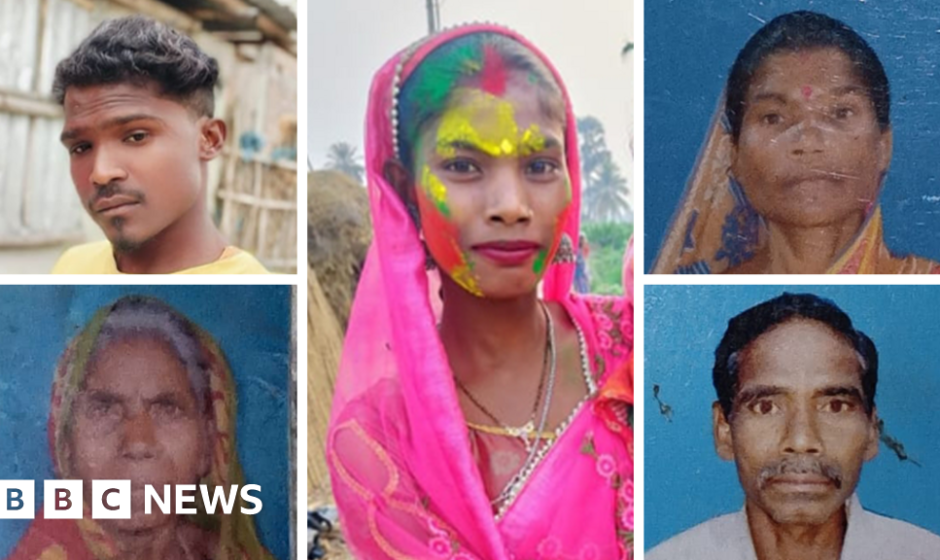Tetgama, Bihar
 BBC
BBCWarning: This story contains details that some may find disturbing.
Three weeks after five members of a family in India were brutally killed and allegedly burned alive amid accusations of the practice of witchcraft, the survivors are still trying to come to terms with the tragedy.
For Manisha Devi (name changed) of Tetgama village in Bihar state, the night of 6 July has been the darkest in her life.
At around 10pm, a belligerent mob gathered outside their relatives’ home – by dawn, five people, including a 71-year-old widow Kato Oraon, were dead.
The incident in Bihar is not an isolated one. According to the National Crime Records Bureau, more than 2,500 people, mostly women, were killed in India on suspicion of witchcraft between 2000 and 2016.
But the Tetgama murders stand out, as five members of a family were killed together.
Campaigners say superstition and belief in witchcraft remain widespread among many of India’s disadvantaged tribal communities, including those involved in the recent Bihar incident.
The alleged murderers and victims all belong to the Oraon tribe and have lived together for generations. But what transpired on the night of 6 July has opened a chasm that is unlikely to be bridged anytime soon.
Tetgama’s streets now echo with silence – all the residents, except four of Kato Devi’s sons and their families, have fled the village. Some homes are locked, while others appear to have been abandoned in a hurry.
The BBC spoke to the victims’ relatives, police and officials to piece together what happened on the night of the killings.

Manisha Devi says she heard a commotion and found a large crowd outside the home of Babulal Oraon, the eldest of Kato’s five sons who lived nearby.
Mr Oraon, his wife Sita Devi, the couple’s son Manjit and daughter-in-law Rani Devi were among those killed. His youngest son, a teenager, is the only survivor.
Police in their first information report (FIR), which is available online, have named a villager – Ramdev Oraon – as the main accused.
They said Ramdev’s son had died about 10 days back after falling sick, but he had allegedly accused Kato Devi and her family of killing his child through witchcraft. It’s not clear what the belief was based on.
Police say Ramdev is absconding and that they are looking for him.
On the night of the killings, Ramdev had allegedly brought his nephew, who appeared seriously unwell, to the victims’ house.
Manisha Devi said she saw the teenager lying on the ground and the village exorcist performing some rituals and reciting mantras.
Manisha Devi, another relative and the survivor in his police complaint have alleged that the exorcist “pronounced Kato Devi and Babulal’s wife Sita Devi as witches, blaming them for the death and illness in Ramdev’s family”.
“Kato was dragged out and given half-an-hour to heal the sick teenager. Sita Devi, who was away visiting her mother in a neighbouring village, was called and asked to return if she wanted to see her family alive,” she added.
The second relative who also witnessed the alleged murders says Kato pleaded with the villagers to see reason, but the mob kept getting angrier.
“When Babulal and Manjit tried to intervene, the mob attacked them too. Rani Devi was also assaulted when she attempted to shield her husband,” she adds. “When Sita Devi returned with her son, the survivor, they too were assaulted.”

The teenager later told the police that he somehow managed to run away, hide in the darkness and watch as his family was lynched and burned.
The police complaint names 23 men and women from the village and “150 to 200 unnamed people who made up the mob”.
“The mob was armed with sticks, rods and sharp weapons. They tied all the five victims with a rope and dragged them to the village pond, assaulting and abusing them all the way,” it says.
The complaint adds that the victims were “half-dead” when they were doused with petrol and set on fire, their bodies were packed in sacks and taken away on a tractor.
A senior police official told reporters the next day that the victims were burned alive and their charred bodies had been recovered from a pond near the village.
District Magistrate Anshul Kumar also initially said the five were burned alive. But he recently told the BBC that the post-mortem report was inconclusive on the issue.
“The report indicates evidence of burn injuries and assault; however, it does not clearly articulate the precise cause of death, whether it was due to burning or whether that occurred post-murder.”
Shockingly, the night-long violence occurred not very far from the Mufassil police station, located just 7km (4.5 miles) away.
Mr Kumar said the police heard about the incident 11 hours after the mob gathered, and acknowledged that it showed “there were shortcomings somewhere” and that “this was our failure”. But the delay, he added, was “since the entire community was involved”.
In the aftermath, the officer-in-charge was suspended. His replacement Sudin Ram told the BBC that four people, including the exorcist, have been arrested. The others are absconding, he said.
“We have invoked laws related to unlawful assembly, rioting, causing grievous hurt by dangerous weapons, wrongful restrain, mob lynching and disappearance of evidence of offence,” Mr Ram said, adding that the guilty could face life imprisonment or the death penalty.
The BBC has not been able to speak to the exorcist, who is in custody, or to Ramdev, whose whereabouts are unknown. The survivor is in protective custody at a safe location and receiving counselling, police official Mr Kumar said, adding that he is “gradually recovering.”
His brothers, who were away working when the attack occurred, are receiving free food and support, he added. They’re currently staying with relatives in a nearby village.
A special investigation team is probing the lynchings, but Mr Kumar said superstition-fuelled hysteria drove the crowd to commit the murders.
Officials say this is the area’s first such incident, with no prior witchcraft cases ever recorded.
But Mira Devi, a local social worker, told the BBC that tribal villages lack education and rely more on exorcists than on doctors or medicine.
Village council head Santosh Singh says most children skip school to work at nearby brick kilns with their parents. A local teacher, Indranand Chaudhary, confirmed only three are enrolled – and none attend.

Tetgama, a tribal village 11km from Purnea town, is home to 22 families.
Across paddy fields, a villager points to burnt maize stalks – the site of the 6 July tragedy.
Narrow mud paths lead to the victims’ homes. At Babulal Oraon’s two-room hut, built from corn stalks, bamboo, and mud, time feels frozen.
In the room where Manjit and his newlywed wife Rani Devi slept, the bed is neatly made, with a clean sheet and the mosquito net tucked in.
Manisha Devi sits outside her home, haunted by the senseless murders she and others witnessed that night.
“We stood helplessly, watching the victims desperately trying to save themselves. That scene still haunts us,” one man said.
#witchcraft #murders #shook #Indian #village



